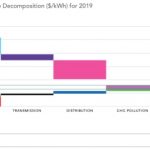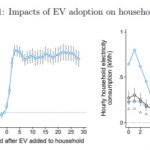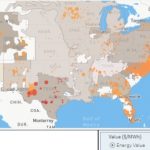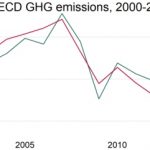Anaerobic digesters are used to turn cow manure into useable methane fuel. But the raw cost of that gas is ten times the market price. On the plus side, emissions are being avoided. So how do you create the incentives that are fair and make it commercially viable? In California, dairy biogas has risen from almost non-existence five years ago to delivering half of all natural gas used for transportation in the state. Aaron Smith at the Energy … [Read more...]
Make EV batteries bidirectional, get GWs of storage for the Grid
How to cope with the hourly, daily and seasonal variation in demand as regions electrify more, depend more on variable renewables like wind and solar, and cut baseload fossil generation? Storage shifts load nicely. But why build grid-scale batteries when millions of little batteries in our EVs are sitting idle in our driveways for most of the time? As Mark Specht at the Union of Concerned Scientists explains, it’s why in California a bill is … [Read more...]
Rooftop Solar: will subsidies benefit wealthy early adopters, while grid limits lock out the latecomers?
Subsidies encouraging homeowners to install rooftop solar are being won by the affluent who can afford to be first movers. And when the technology has come down in price, the remaining majority of households will be shut out of the benefits of own-generation because the grid won’t have the capacity to integrate everyone. That’s the argument made by Juan Jose Cuenca Silva, Barry Hayes and Hannah Daly at the University College Cork who summarise … [Read more...]
Evidence of a direct link between Wildfires and Fossil Fuel firms. Can it be used to sue them?
Wildfires are back in the news. The link to rising global temperatures caused by climate change is clear. Mark Specht at the Union of Concerned Scientists summarises their study that, for the first time, puts a number on the level of responsibility attributable to fossil fuel companies. Rising temperatures create a “vapour pressure deficit,” a measure of the power of the air to dry out plants and trees. That leads to an increase in the area … [Read more...]
Pollution costs are driving U.S. states to look for alternatives to Gas-Fired Plants
In the U.S. a growing number of states and regulators are directing utilities to look for alternatives to proposed gas-fired power plants, citing environmental justice and community health impacts, explain Caitlin Odom and Lauren Shwisberg at RMI. So it’s not just about emissions: pollution matters too. The authors quote studies that show clean energy portfolios (CEPs) not only reduce energy costs, but can save billions of dollars in community … [Read more...]
U.S. Residential Distributed Solar: still getting cheaper, installation and permitting too, more batteries
John Rogers at UCS reviews the new and comprehensive “Tracking the Sun” report from Lawrence Berkeley National Laboratory which covers both residential and non-residential “grid-connected, distributed” solar PV systems in the U.S. There has been clear progress across the board, including PV module efficiency, system costs, installation and permitting, and the uptake of batteries. For example, median efficiency for modules in residential systems … [Read more...]
If most truck journeys are less than 300 miles the E-Truck revolution can happen now
What proportion of trucks today could go electric? That’s the question Emily Porter at RMI has asked for California and New York. The answer is 65% of medium-duty trucks and 49% of heavy-duty trucks. Those are very encouragingly high numbers. RMI’s definition of “electrifiable” is if they travel fewer than 300 miles between trips to their home bases. The study gathered real data on how freight trucks are driven today. Clearly, a large number of … [Read more...]
U.S. Solar breaks new records. What’s needed to keep the momentum?
The latest available data reveals it’s been a record breaking 2021 for U.S. solar. John Rogers at UCS runs through the highlights. Solar passed the 100GW milestone, with 23.6GW newly installed, up 19% on 2020 and 77% up on 2019. Solar was the biggest source of new electric generating capacity for the third year in a row. Residential, non-residential and utility-scale all performed well. Across the nation, solar accounted for 3.9% of total … [Read more...]
Solar + Storage Hybrid plants are poised for explosive growth in the U.S.
At the beginning of 2021 the U.S. had 73 solar and 16 wind hybrid projects, amounting to 2.5GW of generation and 0.45GW of storage. By the end of 2021, over a third of the 675GW of solar in the grid connection queue were hybrids, and 19GW were wind hybrids. Only one in four typically get approved, built and connected. But that still points at a twenty-five-fold increase in hybrid generation. It’s why Joachim Seel, Ben Paulos and Will Gorman at … [Read more...]
Can Carbon Offset loopholes be fixed with better evaluation and rules?
Carbon offset programmes rightly get a lot of criticism. There’s plenty of evidence of offsets not delivering all the GHG emissions reductions they are credited for. Though still on the international agenda, should they be ditched? Or can they be improved with better analysis and evaluation, and making that a pre-condition for creating carbon offset credits, asks Meredith Fowlie at the Energy Institute at Haas. She starts by looking at those … [Read more...]
California: Designing electricity rates that are fair and encourage EV and Heat Pump take-up
Electricity prices in California are not fair and not good for incentivising electrification, says James Sallee at the Energy Institute at Haas, because of the way people are being billed. There is no doubt that electrification (grid upgrades, etc.) and climate mitigation (including controlling California’s wildfires caused by power cable failures) must add to the cost of transition. But Californians can now find themselves paying up to twice the … [Read more...]
Case studies: Strategic EV funding starts with an Essential Charging Network
Building a nationwide EV charging network is a daunting prospect. Camille Kadoch and Julia Hildermeier at RAP look at those places that are being strategic about it, starting with an essential network that will allay the concerns of consumers on the verge of buying an EV but put off by worries that they will get stuck somewhere with a flat battery. That’s frustrating, given the average American drives only 37 miles a day and Europeans 32 … [Read more...]
Are EV owners driving less than we thought?
Research from California, the EV leader in the U.S., suggests that EV owners drive their vehicles half as much as the average gasoline car owner. Catherine Wolfram at the Haas School of Business explains that their research project reveals mileage data is so hard to gather that it’s difficult to know what’s actually going on. Is the data wrong (they don’t think so), or are EVs only being bought by drivers who don't use a car much? If so, the … [Read more...]
New Berkeley Lab Report Documents Trends in System Impacts, Reliability and Market Value of Solar in the United States
By Andrew Mills and Joachim Seel, Berkeley Lab As solar generation increases, it is expected to progressively impact the bulk power system—changing prices for energy and other grid services. Solar generation is driven by sunshine and thus often highly correlated over the course of a day within a region. Without the deployment of storage or an increase in price-responsive load, growth in solar capacity is … [Read more...]
We’re making much more progress decarbonising Electricity than Transport. Why?
In the OECD, since 2000, electricity sector emissions have fallen by 8% while transport emissions have actually increased by 5%. The best performers like the UK recorded drops in both: 40% and 6% respectively. In the U.S. it’s 25% and 0%. Catherine Wolfram at the Haas School of Business asks why transport is still going in the wrong direction, given the power sector’s progress. She posits three theories. Rich nations are outsourcing … [Read more...]
















